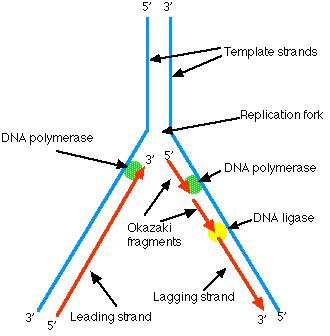How does the antiparallel structure of the double helix affect replication?
1 Answer
One of the main ways DNA's antiparallel structure affects replication is in the way DNA polymerases build the new strands of DNA. DNA polymerase is the enzyme that connects nucleotides to make the new DNA in this process. DNA polymerases only work in the 3' to 5' direction so on one of the DNA strands this is easy as it opens up in that direction. But on the other strand (the lagging strand) the enzyme must work in the opposite direction, meaning it can only build discontinuous fragments as the double helix unwinds.
Here's an image that help make sense of this:

You can see that the leading strand is built continuously, going toward the direction of the replication fork. The lagging strand is built in fragments (called Okazaki fragments), moving away from the replication fork.
If you want more information, here's a very helpful animation:
DNA Replication Animation

